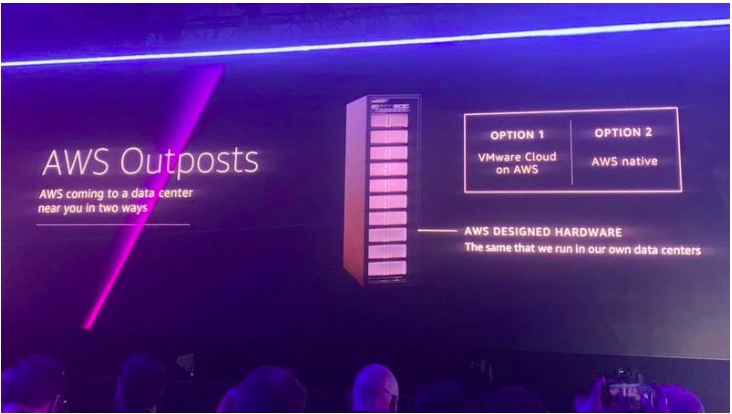
At Amazon’s re:Invent 2018 conference, Amazon finally announced their venture into on-premises data-centers, called AWS Outposts. Just a few years ago, this would have been unthinkable, given how Amazon executives would proclaim the inevitable death of on-premises infrastructure and private clouds. While AWS Outposts is in a very early technical preview, I wanted to share 7 key insights from the information available at this time.
1. On-premises environments aren’t going away
For years, the world’s largest federal and enterprise customers have resisted Amazon’s call to dump their data-centers and move everything into the AWS cloud. Today’s announcement is a testament that Amazon recognizes the importance of on-premises environments, despite the company’s previous claims to the contrary. Growth in the public cloud market is slowing because AWS is starting to saturate most customers that were willing to move away from on-prem data-centers. Today’s announcement is a huge validation for customers who have been pursuing a hybrid cloud strategy.
2. “Fully managed” is the standard operating model for cloud
The public cloud’s secret sauce has really been its operating model, which provides a seamless, self-service consumption (and management) experience for computing, at scale. AWS Outposts brings that operating model to on-premises infrastructure, albeit with AWS proprietary services (such as EC2, ELB, etc.), integrations and tools. This is a significant validation of the SaaS operating model for our own hybrid cloud platform, and establishes this operating model firmly as the new standard for how clouds everywhere will be managed – whether on-premises or in public clouds.
3. Cloud is finally about services and operating model, not about where the infrastructure lives
For years, AWS and other public cloud providers have propagated a vision of ‘cloud’ as the ultimate destination. In reality, enterprises have struggled with the desire to consume both the agility and speed of cloud computing not just on public clouds, but also while using their existing infrastructure, or infrastructure located at edge locations, or a combination thereof. With this announcement, the days of talking of cloud as a destination are over. Cloud is not where your apps are hosted, but rather it is about the experience of how compute services are provisioned and operated at scale to accelerate innovation and enable business value, regardless of where infrastructure lives.
4. Enterprises still need to consider hardware and cloud compatibility
While AWS’ Outposts announcement is light on details, it looks like the offering is built on an AWS proprietary hardware and software stack with another variant that integrates VMware’s components. This is how AWS is looking to deliver a so-called “unified cloud experience”. But what about enterprises that don’t want to be locked-in to either AWS or VMware?
There are three critical considerations for large enterprises that potentially make this offer a no-go for large organizations::
- Existing hardware: The world’s largest enterprises are running billions – billions – of x86 compute cores in a variety of existing deployments. AWS Outposts don’t work with those existing investments, which is a huge cost and efficiency consideration.
- New infrastructure technologies: For anyone deploying new infrastructure today, there are really compelling new technologies, ranging from Hyperconverged, Composable and Converged architectures. There are innovations available from these providers (e.g. data replication, fault tolerance, and others) that are valuable for enterprises. Using an AWS-proprietary infrastructure stack could prevent the adoption of new innovations from the broader technology ecosystem
- Cloud compatibility and portability: Finally, there is the fact that many enterprises don’t want to be locked-in to one cloud provider, or may have strategic partnerships with Microsoft; or value new technologies being launched by Google Cloud.
5. Simplicity will be a key battleground for on-premises solutions
Enterprise customers have long struggled with the complexity of deploying and managing technologies like cloud orchestration platforms, SDN controllers, with their innumerable configurations and resource intensive control planes. This has historically manifested in a complex day-2 experience, making it difficult for enterprises to scale on-premises private clouds effectively.
AWS Outposts incorporation of some of VMware’s cloud technologies is interesting because products such as the NSX SDN layer and vRealize Automation cloud platform are notorious for being very complex to deploy and manage. The good news is that AWS’ Outposts bare metal may have fewer dependencies on non Amazon-built components, which will likely mean a much better customer experience.
However, keep in mind that the AWS-native variant of Outposts also requires advanced knowledge of operating AWS’s specific services, and lock-in to those, alone. As more technologies emerge to compete with AWS Outposts, simplicity and interoperability will become a key consideration for enterprise customers.
6. Costs will remain a major concern and selection criteria
Many enterprise customers choose to use cloud computing despite, not because of, the cost of infrastructure. As any customer of Amazon’s cloud knows, using AWS cloud especially at scale is not cheap, but you do get a great cloud computing experience. With Amazon now providing some of that same experience on-premises, but including their proprietary hardware (and, optionally, the VMware product suite), costs will continue to remain high and will remain a major concern for enterprises looking to run cloud infrastructure at scale.
7. Enterprises will have to make big bets if they are for or against cloud agnostic and Open-source solutions
All of these lead to my final point: The battle for hybrid cloud is heating up. Every cloud vendor is launching their unique on-premises offerings, offering greater flexibility than before for enterprise customers. Compatibility and being able to leverage existing investments in infrastructure and technology stacks, alternative infrastructure technologies, multiple cloud providers and costs — will be the key considerations for enterprises in choosing their hybrid cloud solution. Open-source solutions – particularly those that are delivered as a managed service to simplify the operating model – will win for enterprises that value flexibility, interoperability, and greater cost efficiency. Cloud provider-specific technologies, like AWS Outposts, will win customers who value their existing relationships with AWS, or do not see any need for multi-cloud in their future (despite evidence to the contrary, that enterprises already operate in a multi-cloud environment).


